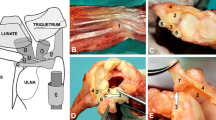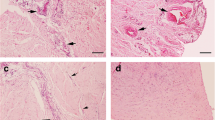Abstract
Free nerve endings (FNEs) of type IVa play a distinctive role in the articular nociceptive and sensorimotor system of the knee. This study qualitatively and quantitatively analyzed FNEs in the medial and posteromedial capsuloligamentous complexes. Biopsy specimens from ten precisely defined anatomical locations were taken from seven fresh cadaver knee joints. The specimens were fixed with 4% formaldehyde solution and stained with hematoxylin-eosin. The results were examined using immunohistochemistry. The occurrence of FNEs is described in combination with their specific pattern of distribution. A high number of FNEs were found in all investigated elements with a maximum relative density in the insertion of the semimembranosus muscle in the direct attachment on the tibial margin. The number was lowest in the superficial medial collateral ligament. The results were correlated with anatomical and biomechanical functions of the stabilizing effect of the medial capsuloligamentous complex. Our findings indicate that lesions and surgical procedures can alter normal sensory feedback and coordination by modifying the use of muscle fiber during specific movements.
Similar content being viewed by others
Author information
Authors and Affiliations
Additional information
Received: 1 October 1998/Accepted: 25 November 1999
Rights and permissions
About this article
Cite this article
Biedert, R., Lobenhoffer, P., Lattermann, C. et al. Free nerve endings in the medial and posteromedial capsuloligamentous complexes: occurrence and distribution. Knee Surgery 8, 68–72 (2000). https://doi.org/10.1007/s001670050188
Issue Date:
DOI: https://doi.org/10.1007/s001670050188




